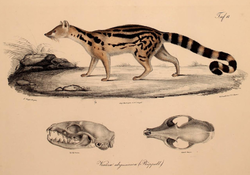| Abyssinian genet | |
|---|---|
 | |
| Scientific classification | |
| Kingdom: | Animalia |
| Phylum: | Chordata |
| Class: | Mammalia |
| Order: | Carnivora |
| Family: | Viverridae |
| Genus: | Genetta |
| Species: | G. abyssinica [2] |
| Binomial name | |
| Genetta abyssinica [2] | |
 | |
| Abyssinian genet range | |
The Abyssinian genet (Genetta abyssinica), also known as the Ethiopian genet, is a genet species native to Ethiopia, Eritrea, Somalia, Sudan, and Djibouti. It is listed as Data Deficient on the IUCN Red List. [1] It is one of the least-known genet species. [4]
